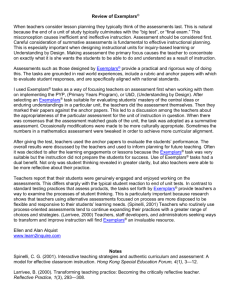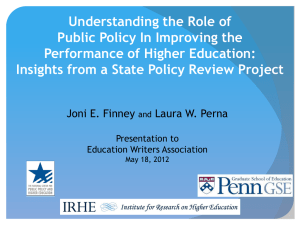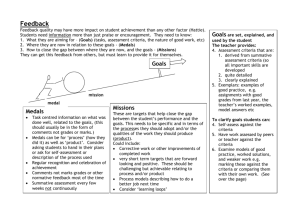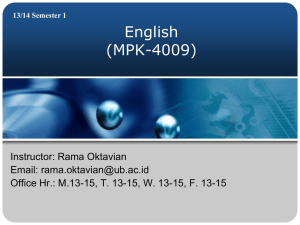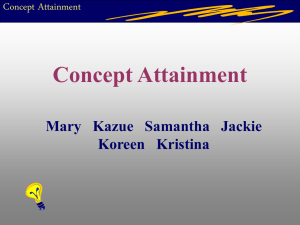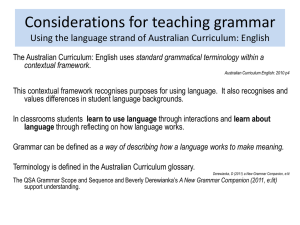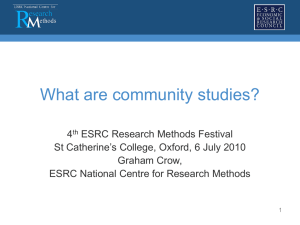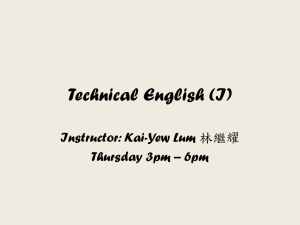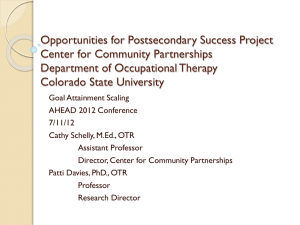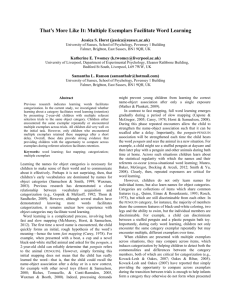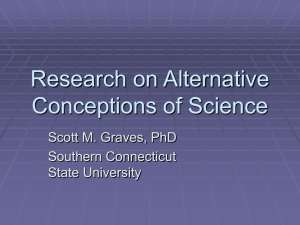Concept Attainment Presentation
advertisement
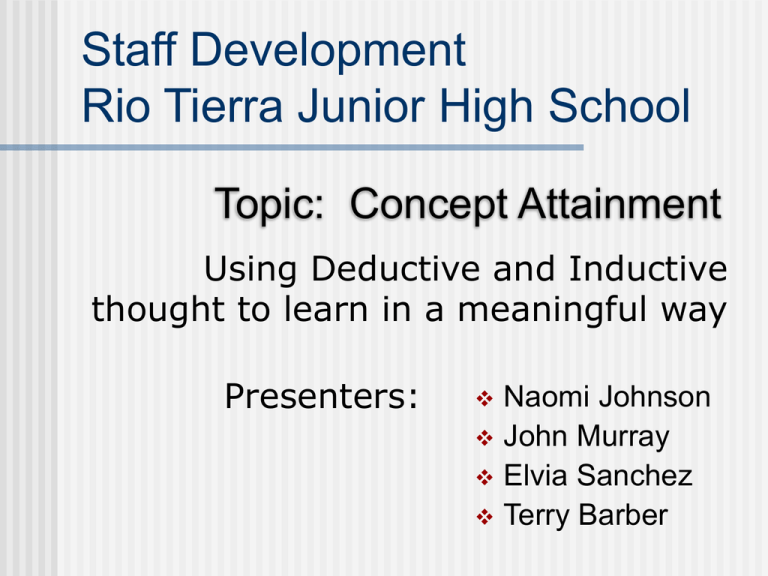
Staff Development Rio Tierra Junior High School Topic: Concept Attainment Using Deductive and Inductive thought to learn in a meaningful way Presenters: Naomi Johnson John Murray Elvia Sanchez Terry Barber What is Concept Attainment? A method of teaching important concepts Uses deductive and inductive reasoning Promotes critical thinking May be used for any subject Technology can assist in concept attainment Three Examples John Murray - Social Studies Elvia Sanchez – Language Arts Terry Barber - Living Skills Example 1 Social Studies John Murray Example 1: Social Studies States’ rights doctrine Rule: An argument that state power should be greater than national power because the states ratified the Constitution that created the national government Concept: Example 1: Social Studies Critical Attributes: 1. 2. 3. States created the national government; therefore, power comes from the states. State power is supreme--not national power. Since state power is supreme, states may nullify federal laws. Example 1: Social Studies Exemplars for Driving the Concept: + South Carolina nullifies a federal tariff + Massachusetts ignores the Fugitive Slave Law - After Congress creates the national bank, Maryland establishes a state bank + Georgia ignores the Supreme Court’s ruling in Worcester v. Georgia; forcibly removes thousands of natives Example 1: Social Studies Exemplars for testing and confirming 1. 2. 3. 4. California ignores federal drug laws and allows medical use of marijuana North Dakota allows growth of industrial hemp, despite federal law Texas starts its own space program Thirty-seven states pass articles of impeachment against the president Example 1: Social Studies Test Results Class 2 concept attainment model averaged 70% correct Class 4 concept attainment model averaged 68% correct Class 5 definition and one example averaged 73% correct Class 6 definition and one example averaged 73% correct Example 2 Grammar Elvia Sanchez Example 2: Grammar Phase I: present labeled examples Phase II: identify labeled examples Phase III: discuss role of hypotheses and attributes Example 2: Grammar Exemplars Non Exemplars On a trip After many years During their stay Outside the door A long trip Many years later The trip to the mall A door is broken Example 2: Grammar Exemplars or non exemplars? 1. 2. 3. 4. 5. In front of the garbage cans Behind the first place winner Walking around the gallery Listening to the radio To the railroad museum Example 2: Grammar Answer Concept: prepositional phrases Rule: Prepositional phrases begin with a preposition Supplemental Technology: PowerPoint http://www.funbrain.com/grammar/index.html More advanced: Exemplars Non Exemplars To the supermarket To laugh at myself Sleeping cat Smiling brightly In the garden Where the car is When you know As they walked in How she remembered If he says so Example 2: Grammar Answer: Concept: Phrases Rule: Phrases do not have both a verb and its subject Example 3 Living Skills Terry Barber Example 3: Living Skills Concept: Poor Working Conditions Rules: The condition could affect the workers production The worker has no ability to change the situation The condition is harsh Supplemental Technology: PowerPoint Internet research assignment Example 3: Living Skills Phase 1: Identify Examples + Joan’s boss often stands behind her and uses obscene language to get her to work faster. - Lillie likes going to work because her boss is respectful to her. + Susan is afraid of being fined by her employer for talking at work. - Jack is confident his boss will allow him to leave work early if he has some important business to take care of. Example 3: Living Skills Phase 1: Identify Examples (Cont’d) + Joan gets headaches because the lights are too low in the factory where she works + Fred works about fourteen hours a day and has no choice about whether or not he works that long - Frank feels energetic after work and has plenty of time for hobbies, friends, etc. - Billy gets breaks every couple of hours to relax and regain his strength; he gets an hour for lunch Example 3: Living Skills Phase 2: Confirm Concept Phase 3: Students label examples __ Cheryl has to share one bathroom with a couple hundred other workers and a family of rats. __ Judy’s company has heat in the winter and air conditioning in the summer. __ Fred gets a raise at least once a year based on his performance. __ Shaka often sees some of the workers arguing and fighting each other at work. Example 3: Living Skills Phase 4: Ask Questions for Assessment Describe your idea of a poor working condition. What did you think the concept of poor working conditions was initially? What gave you the most clues? What strategy did you use to find the answers? How can you use this thinking for other problems? Resources Pritchard, Florence Fay. 23 July 1994. Teaching Thinking Across the Curriculum with the Concept Attainment Model. Nelson, Mike; Pan, Alex. Oct 1995. Integrating the Concept Attainment Teaching Model and Videodisk Images. Johnson, Julie. 01 Jan 1992. Developing Conceptual Thinking: The Concept Attainment Model. Clearing House, Vol v66, Issue Nov-Dec
